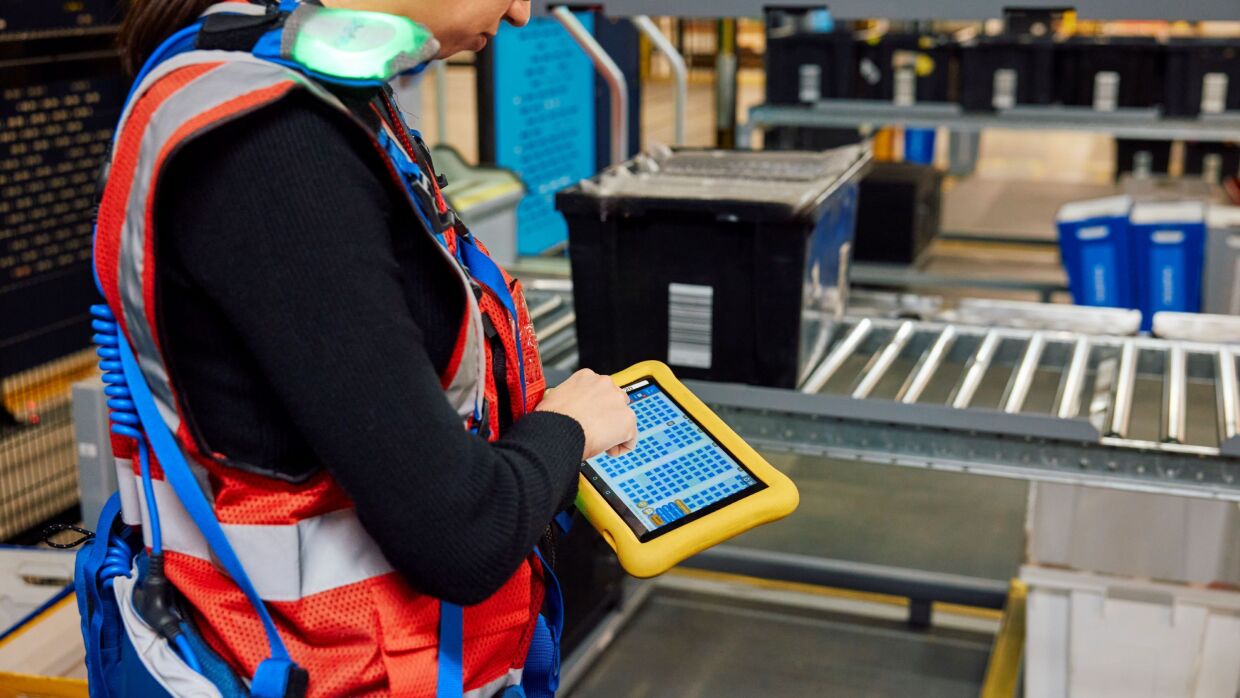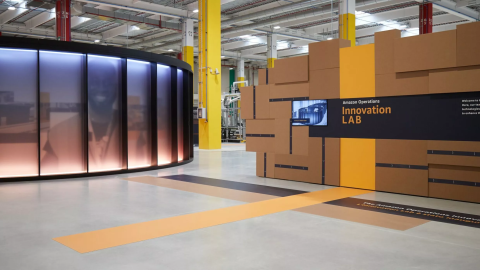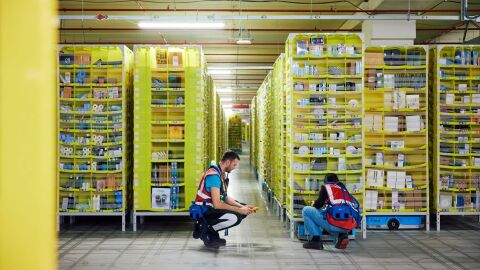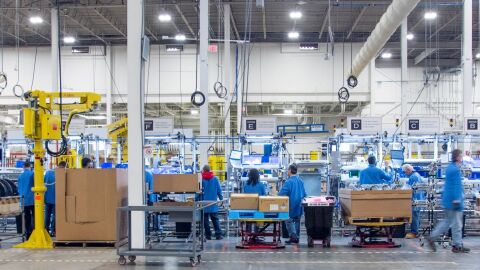Every year, we deploy hundreds of thousands of robots and new automation technology across our worldwide operations network. As the world’s largest manufacturer of industrial robotics, we’ve seen firsthand how investing in new technology can positively enhance our workplace, creating safer and more efficient facilities where employees gain new skills and grow their career. A critical component of our approach to new technology is ensuring we have the right training in place to maximise impact. This requires our teams of operators, technologists, and learning and development professionals to work together and constantly plan for the future.
Creating a safer workplace with technology
The Amazon Operations Innovation Lab in Vercelli, Italy, launched today April 11, is Europe’s hub for new technologies, including advanced robotics and artificial intelligence (AI)-powered innovation. It’s a great example of where our safety experts, engineers, technicians, and AI scientists work hand-in-hand to develop and test new technology before rolling it out across our network.
At the opening celebration for the Lab, Sarah Rhoads, VP Global Workplace Health & Safety, emphasised on our continued focus on investing, innovating, and inventing on behalf of safety: “Employees are the heart and soul of our operations which is why the technology we deploy at our sites is always focused on serving our team and making our operations safer. Our continued investment in robotics helps reduce employees' physical workload and repetitive tasks that can cause injuries, while also helping them gain new skills that can advance their career.”
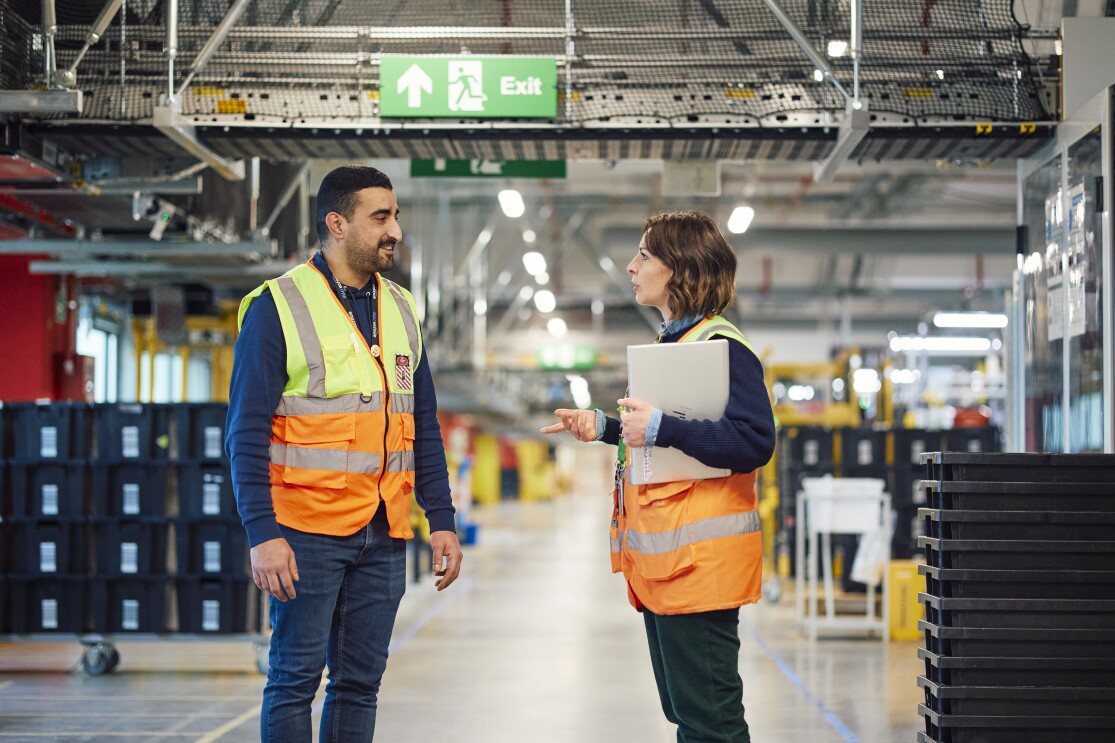
This March, we released our 2023 safety data for our operations network, and it shows we’re continuing to make year over year progress worldwide. Our global recordable incident rate (RIR) – which includes any work-related injury that requires more than basic first aid treatment – has improved 30% over the past four years, and our global lost time incident rate (LTIR) – which includes any work-related injury that requires someone to take time away from work – has improved 60% over the past four years. Our latest safety metrics represent measurable and meaningful progress and are a direct result of more than $1 billion invested in safety initiatives, technologies, and programmes since 2019. In 2024 alone, we’ve allocated $750 million to further our safety efforts, with a focus on ergonomic improvements.
Musculoskeletal disorders (MSD), more commonly known as strains or sprains, are the most common forms of injuries to occur in warehousing or transportation companies. They’re why we’re focused on reducing repetitive motions, such as lifting and lowering objects, or improper posture when working. This is where robotics can really help make a difference. Just last year, we introduced new and sophisticated technology in our fulfilment centres that guides employees to pick and stow products in their ergonomic power zones – the area between the shoulder and mid-thigh. As a result of this investment, we’ve seen an average 5% improvement in the cumulative forces acting on the lower back, and an average 7% improvement on the shoulder.
With over 1.1 million employees working in our operations, small safety process improvements can have a big impact at scale. That’s why a key part of getting safety right is creating a work culture where every employee feels engaged and empowered to help build and maintain a safe environment. To support this, we’ve created a series of feedback mechanisms to ensure we are listening to employees on how to improve safety. One example is Dragonfly, a tool—available on employees’ devices— that lets them easily share safety concerns and suggestions to their managers who can take appropriate action. In 2023 alone, we successfully actioned over 200,000 Dragonfly observations to help make our sites safer.
Investing in skills training and higher-paying jobs
We’re committed to ensuring our employees have the resources and training they need to perform their jobs safely, as well as the support they need to advance their careers and maintain good mental health. Any time we introduce new technology to our sites, we need to rigorously train our employees to ensure they’re comfortable working alongside it.
Since introducing robots within Amazon’s operations, we’ve hired hundreds of thousands of employees to work in our facilities and created more than 700 new job categories worldwide. In our European fulfilment centres alone, 50,000 jobs have been enhanced over the last decade by the innovations like the ones we develop in Vercelli. These new roles highlight how new technology, such as AI-powered robotics, sorting technologies, and autonomous mobile robots, can benefit employees and prepare them for the work environments of the future. Roles we train for include, for example, robotics floor monitors and technicians. Employees in these roles help facilitate the safe operation of mobile robots that move inventory across our buildings. We also hire reliability maintenance engineers who help keep all of the technology running at our sites. These roles require skills training in mechatronics and robotics, and we have programmes in place to offer the industry certifications and skills training that employees need to transition onto these teams.
Robert Marhan, VP of People eXperience and Technology for our Operations network in Europe, started his career at Amazon on the shop floor of a fulfilment centre in Germany, and explains how this benefits employees: “Designing, manufacturing and deploying robotics across our operations network creates new roles at Amazon and opportunities for our employees. In our European fulfilment centres alone, 50,000 jobs have been enhanced by the innovations like the ones we develop in Vercelli. I strongly believe that the modern work environments of the future will keep creating opportunities to acquire new skills and foster professional growth.”
Technology is also opening the doors to a more diverse workforce. Closing the technical skills gap creates opportunities for groups that would otherwise not have access to these positions. In 2014, we launched Career Choice in Europe to enhance employees’ skillsets and expand their career opportunities at Amazon and beyond. Career Choice offers a pathway to higher paying jobs with pre-paid tuition for industry certifications, as well as language proficiency programmes. Some of the most popular areas of study are in the field of technology and transportation. Since 2012, over 200,000 employees worldwide have pursued certifications or furthered their education through Career Choice training programmes.

Gaining perspective and planning ahead
To help prepare employees for the skills that will be in-demand as new technologies get deployed, it’s important for us to understand how employees perceive the use of technology in the workplace. That’s why last October, we announced our partnership with the Massachusetts Institute of Technology (MIT) to study the impact of automation on work. Through this partnership, we’re supporting the expansion of MIT’s automation clinic, which assists engineering researchers working to better understand how employees and organisations are affected by emerging technologies like robots and AI. Our collaboration also supports an MIT-led study in partnership with Ipsos, the polling research firm, to gauge public and employee sentiment around the use of robotics and AI in industrial settings. MIT worked independently with Ipsos to develop the study and conducted polling in nine countries this year, including the U.S., France, Germany, Italy, Poland, Spain, the UK, Australia, and Japan.
MIT is currently analysing the data from this research and plans to release its findings later this year. According to Ben Armstrong, Executive Director of MIT’s Industrial Performance Centre: “We are excited by the potential for this partnership to generate new knowledge about the impact of new technologies at work – and put it into practice in ways that benefit both employers and their workers. This survey is a significant first step in helping us learn what motivates workers to work with new technologies – and the conditions under which they think those technologies can make their jobs better. Our early findings are that workers across countries have strongly positive perceptions about how automation can improve their safety and autonomy at work, as well as their abilities to acquire new skills. Workers are more hesitant about the potential impact of automation on their wages and job security. But there are clues in the data that suggest ways workers can feel more comfortable with automation. Workers report more positive attitudes toward the impact of automation when they say their employer is invested in them, and when they have more direct experience with advanced technologies like robots. There’s much more to come from this survey, and we’re looking forward to sharing more as this collaboration grows.”
At Amazon we’re constantly innovating as we strive to be Earth’s Best Employer through novel advances in robotics and AI that are shaping how we design the warehouse of the future. While we’ve already made great strides, we’re just getting started, so stay tuned for what’s to come!


